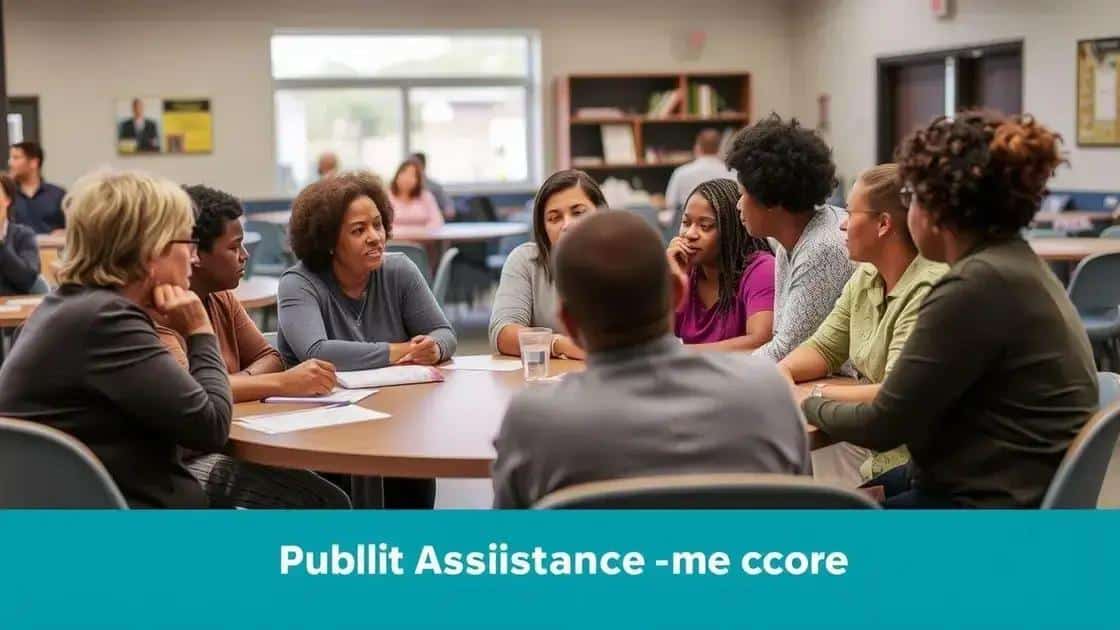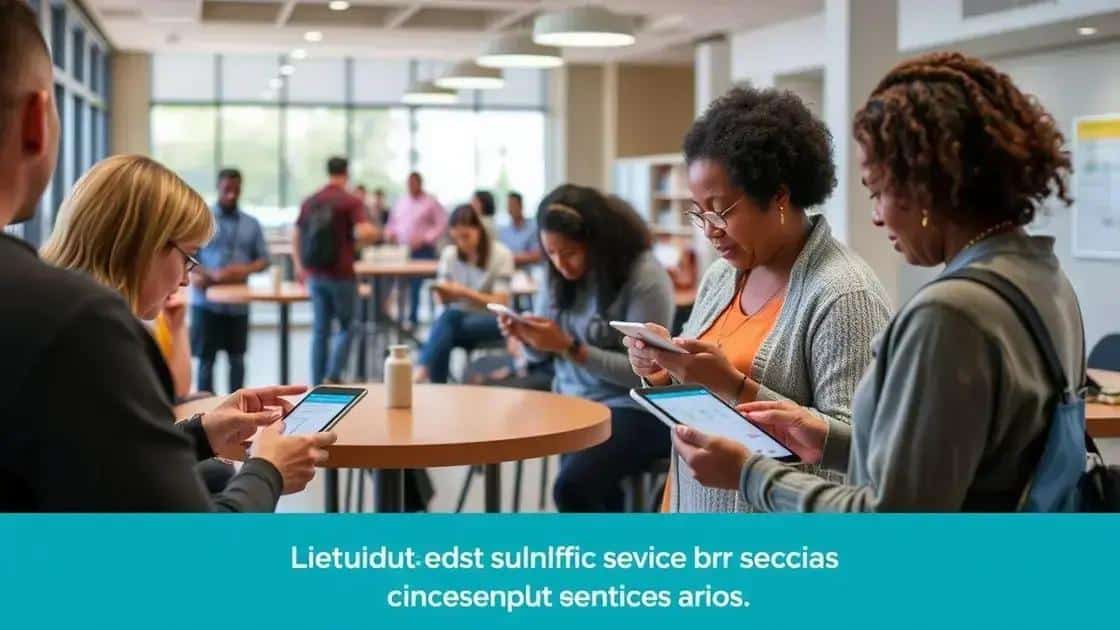Debate public assistance access: what you need to know

Access to public assistance programs is crucial for low-income communities, as it provides essential resources, enhances economic stability, and improves health outcomes, fostering a more equitable society.
Debate public assistance access is essential as it shapes the lives of countless individuals. Have you ever wondered how this access affects your community? Let’s dive into the intricacies and explore the issues at hand.
Understanding public assistance programs
Understanding public assistance programs is vital for anyone trying to navigate support systems. These programs are designed to help individuals and families meet their basic needs, especially during challenging times.
What Are Public Assistance Programs?
Public assistance programs provide financial aid and services to those who qualify. They aim to support individuals who may struggle with poverty, unemployment, or disability. There are various programs available, each targeting different needs.
Types of Public Assistance Programs
- Food Assistance: Programs like SNAP help families purchase food.
- Cash Assistance: Temporary cash benefits support families in need.
- Medical Assistance: Medicaid offers health coverage for eligible low-income individuals.
- Housing Assistance: Programs like Section 8 help with affordable housing options.
Eligibility for these programs often depends on several factors like income, family size, and resources. Understanding the application process can be complex but is essential for securing benefits. Many applicants may feel overwhelmed or uncertain about their eligibility.
Moreover, public assistance programs are crucial in reducing poverty and improving overall community health. When families can access these resources, they find stability. It can lead to better education, improved job prospects, and healthier living conditions.
It’s important to note that while these programs aim to help, there can be barriers to access. Many eligible individuals may not be aware of the available programs or how to apply. Some may face challenges including stigma or complicated forms and procedures.
By raising awareness and simplifying the process, communities can ensure that more people benefit from public assistance programs. Support from local organizations can also guide families in accessing these vital resources effectively.
Challenges to accessing public assistance
Many individuals face significant challenges when trying to access public assistance. These barriers can hinder their ability to receive the support they need. Understanding these challenges is crucial for improving access.
Common Barriers
Access to public assistance is often complicated by various factors. Many eligible individuals may find the application process overwhelming. Some common barriers include:
- Lack of Awareness: Many people do not know about available programs or eligibility requirements.
- Complex Application Processes: Detailed forms and documentation requirements can discourage applicants.
- Stigma: Societal attitudes may lead individuals to feel embarrassed about seeking assistance.
- Limited Resources: Some communities lack access to information or support services that help with applications.
Moreover, cultural and language differences can further complicate the situation. For non-English speakers or those from diverse backgrounds, understanding the system can be a daunting task. This often leads to frustration and feelings of helplessness.
Many applicants also struggle with technology. Online applications and resources are not always user-friendly, especially for those unfamiliar with digital tools. A lack of internet access in certain areas also poses a major hurdle.
The consequences of these challenges can be severe. Individuals may miss out on essential benefits that could improve their quality of life. Some may even fall deeper into poverty due to inadequate support. Addressing these barriers is essential for creating a more inclusive support system.
To overcome these challenges, community outreach programs are increasingly important. Providing proper support and guidance can make a significant difference. Training staff to assist potential applicants can lead to higher participation rates in public assistance programs.
Innovative solutions to improve access

Innovative solutions can significantly enhance access to public assistance programs. By implementing new strategies and leveraging technology, communities can better serve their residents.
Technology Integration
One promising approach is the integration of technology. Digital platforms can streamline the application process, making it more user-friendly. This helps reduce confusion and encourages more people to apply.
Mobile Applications
Many organizations are developing mobile applications that provide information on available services. These apps can help users check their eligibility and apply right from their smartphones. Here are some benefits of mobile applications:
- Accessibility: Users can access information anytime and anywhere.
- User-friendly Interfaces: Simplified navigation helps users find what they need quickly.
- Notifications: Users receive timely updates on their applications.
- Resource Links: Apps can connect individuals to local resources and support services.
Another innovative solution involves community outreach initiatives. By engaging directly with underserved populations, organizations can build trust and facilitate better access. Outreach can include workshops, informational sessions, and one-on-one consultations.
Additionally, partnerships between government agencies and nonprofits can strengthen access to public assistance. By working together, these organizations can share resources and create more comprehensive support networks. Collaborating on initiatives such as free legal aid or financial counseling can remove obstacles for applicants.
Training staff to be more culturally competent is also essential. Understanding the unique challenges faced by different communities can lead to more effective assistance. This approach ensures that services are relevant and tailored to the individuals seeking help.
Impact of access on low-income communities
The impact of access to public assistance programs on low-income communities is profound. Proper access can transform lives, providing necessary resources and opportunities.
Economic Stability
When individuals can access public assistance, they find greater economic stability. This support helps families afford essential needs such as food, housing, and healthcare. By alleviating financial stress, individuals can focus on finding jobs or obtaining education, leading to long-term benefits.
Health and Well-Being
Access to public assistance also significantly affects health outcomes. Families that receive help are more likely to seek medical care when needed. This access helps prevent serious health issues and promotes overall well-being. Some benefits include:
- Increased Access to Healthcare: Families can afford essential medical services.
- Better Nutrition: Food assistance provides healthier diet options.
- Improved Mental Health: Financial security can reduce stress and anxiety.
- Enhanced Child Development: Stability leads to better educational outcomes for children.
Moreover, when low-income communities have better access to these programs, it fosters a more equitable society. It reduces disparities that often marginalize vulnerable populations. Communities thrive when everyone has the tools to succeed.
Unfortunately, many communities still face barriers to access. These challenges can create damaging cycles of poverty. This highlights the importance of addressing the root causes of inequality and ensuring that all individuals are aware of their rights and the support available to them.
Moreover, investing in community outreach can enhance access and improve the overall impact of public assistance programs. Workshops and informational sessions can educate families about their options and simplify the application process.
Future of public assistance access
The future of public assistance access is poised for transformation as technology and community initiatives evolve. Enhancing access for all individuals can lead to better outcomes.
Embracing Technology
In coming years, technology will play a critical role in improving access to assistance programs. Mobile apps and online platforms will simplify application processes and provide real-time updates. This shift aims to make resources more accessible for everyone.
Data-Driven Decisions
Governments are beginning to utilize data analytics to identify gaps in service. By understanding where access issues lie, policymakers can implement targeted solutions. Key actions will include:
- Identifying Barriers: Determine common obstacles faced by applicants.
- Improving Outreach: Target communities most in need of assistance.
- Accessing Resources: Utilize data to direct funds and services efficiently.
- Measuring Impact: Continuously evaluate the effectiveness of programs.
Additionally, community partnerships will become increasingly important. Collaboration among non-profits, local governments, and private organizations can expand resources and outreach. These partnerships can address specific local needs and ensure that no one falls through the cracks.
Educational initiatives will also emerge to raise awareness about available resources. Workshops and training programs will provide families with information regarding their rights and options. Educating communities about public assistance will empower individuals to seek help.
The trend toward inclusivity will shape the future of public assistance access. Focused efforts will aim to make programs available to all, regardless of background or circumstance. This shift will not only improve access but also foster a more equitable society.
FAQ – Questions about Public Assistance Access
What is public assistance?
Public assistance refers to government programs designed to provide financial aid and support services to individuals and families in need.
How can I apply for public assistance?
You can apply for public assistance through online applications, local government offices, or community organizations that provide guidance and support.
What barriers exist in accessing public assistance?
Common barriers include lack of awareness about available programs, complex application processes, and stigma associated with seeking help.
How will technology impact the future of public assistance?
Technology will streamline application processes, making resources more accessible and enabling real-time updates for applicants.





